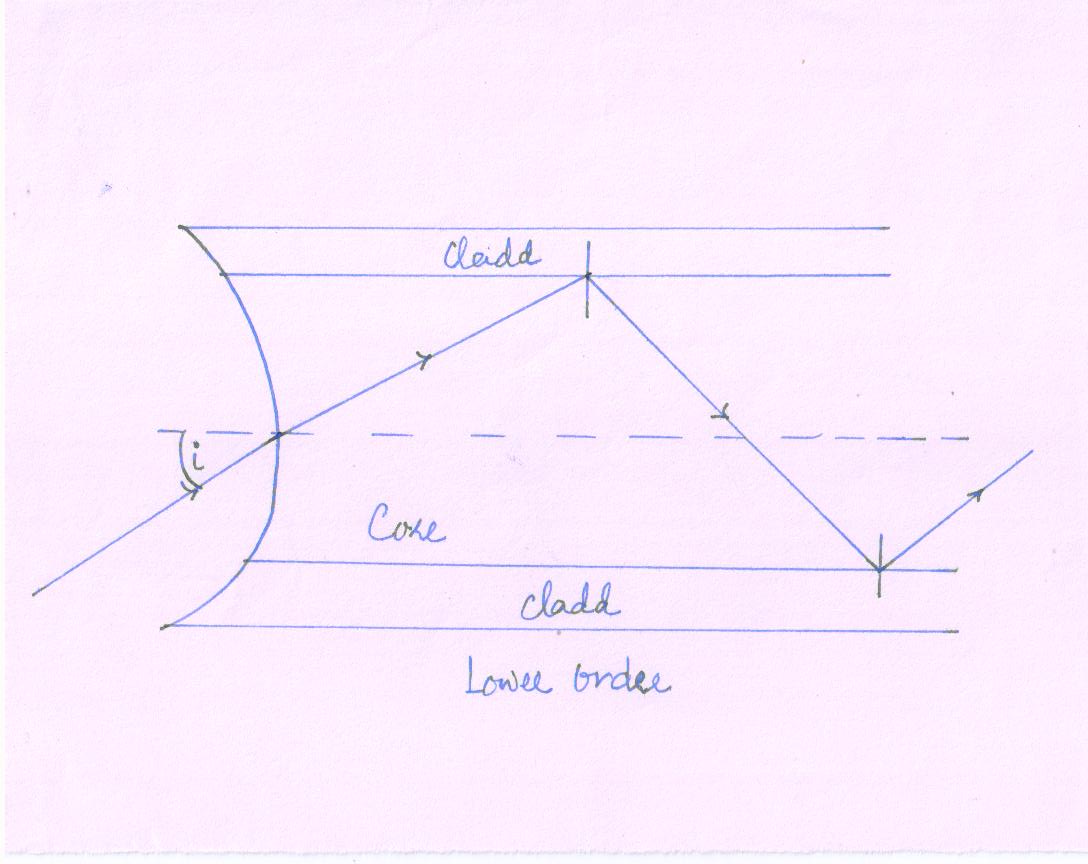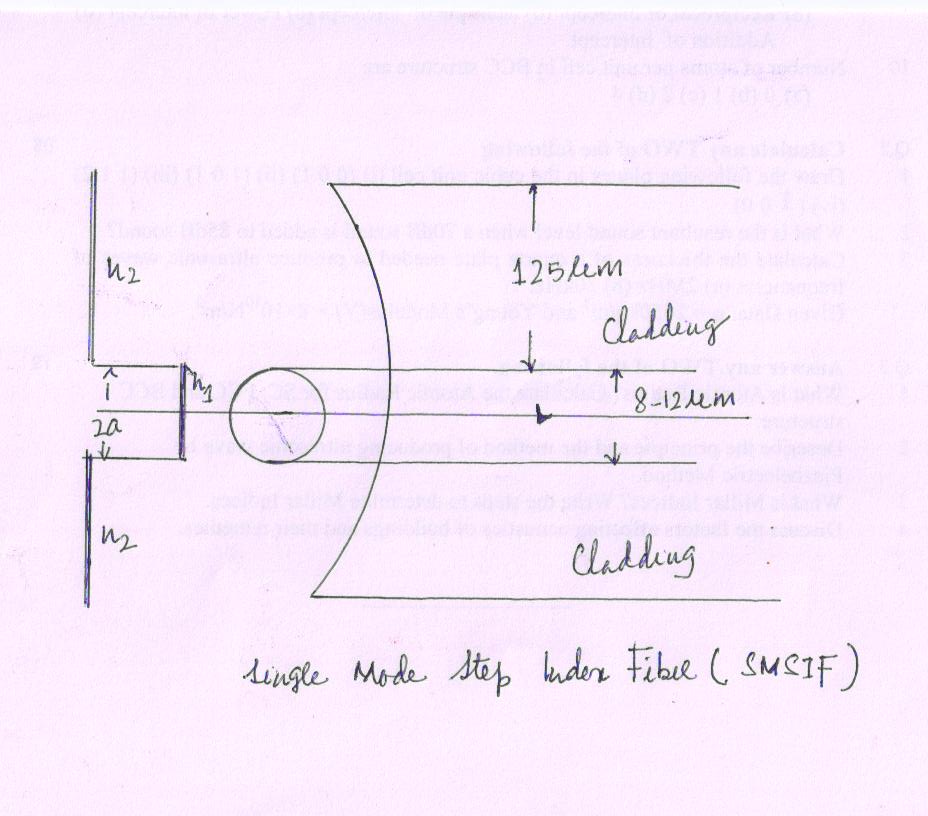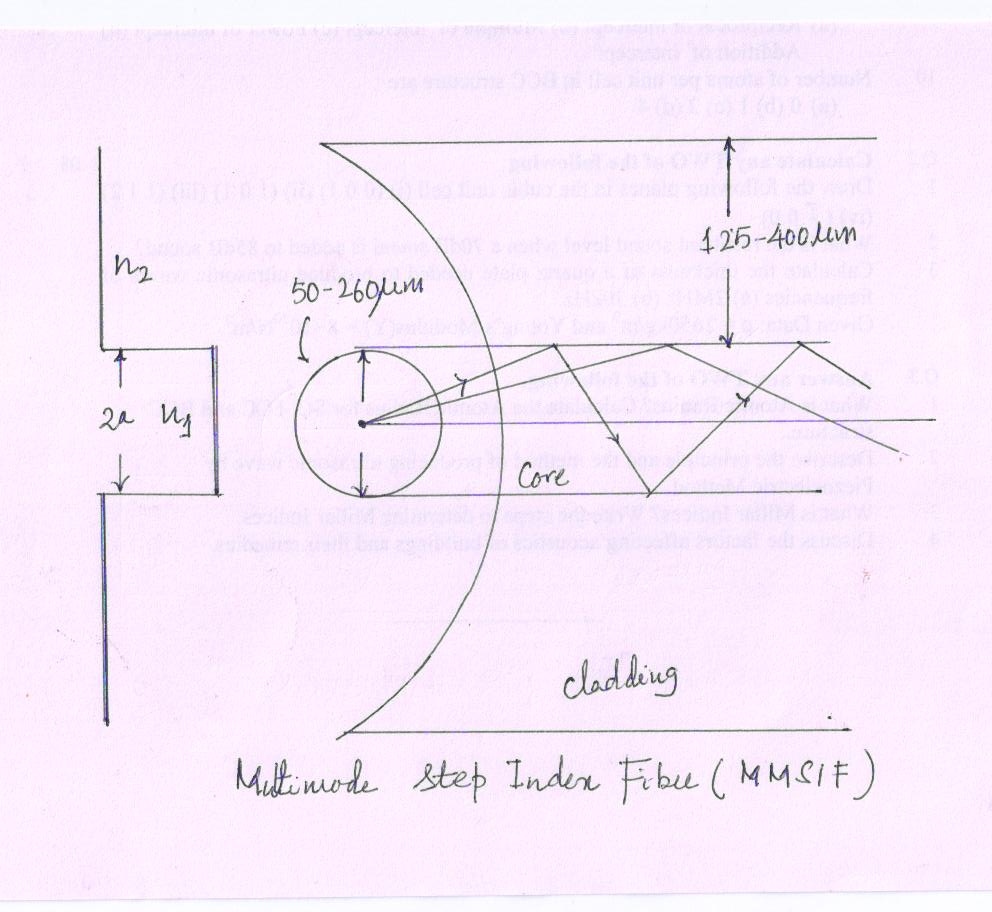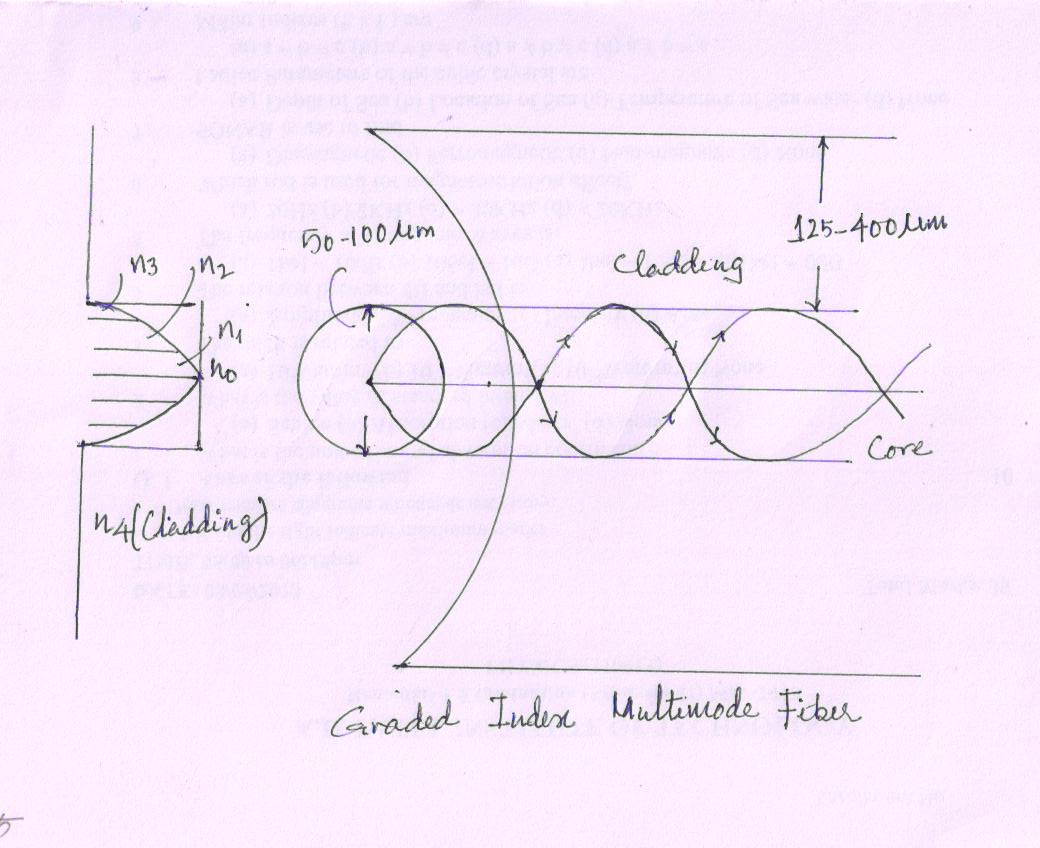Site pages
Current course
Participants
General
MODULE 1. Magnetism
MODULE 2. Particle Physics
MODULE 3. Modern Physics
MODULE 4. Semicoductor Physics
MODULE 5. Superconductivty
MODULE 6. Optics
5 April - 11 April
12 April - 18 April
19 April - 25 April
26 April - 2 May
LESSON 30. Theory of Optical Fiber - Mode of Propagation
Type of Mode
Fiber thickness is fixed;
The mode, that propagate at angles close to the critical angle are higher order modes.

Fig.20(3, 3a)
Fields are distributed more toward the edge of the wave guide and tend to send light energy into cladding. As result energy may loss.
It has transverse longer path and hence it takes larger time than the lower order mode to cover given length of fiber. As a result higher order mode arrives at the end of fiber later than lower mode.
The mode, that propagates with angle larger than the critical angle are called lower order mode. Fields are concentrated near center of the fiber.
Single Mode Step Index Fiber (SMSIF)

Fig 20(4)
Structure:
-
SMSIF has a very fine thin of core diameter of 8-12 \[\mu m\]
-
It is prepared by Ge doped silicon.
-
The core is surrounded by a thick cladding of lower refractive index compared to core.
-
Cladding is prepared by composed Silica lightly doped with phosphorus Oxide.
-
The diameter of cladding is 125 \[\mu m\] .
-
This fiber is surrounded by opaque protective sheath.
-
RI of the fiber changes abruptly at core-cladding interface.
-
The variation of RI of SI fiber as a function of radial distance (n(r)) can be mathematically.
n(r) = n1 (r < a; inside the core region)
n(r) = n2 (r > a; inside the core region)
Propagation of light through (SMSIF)
-
Light travel in SMSIF is single path.
-
It is zero order modes.
-
Fractional Refractive Index (Δ) and numerical aperture (NA) are very small for SMSIF; Δ is small obtained by reducing the radius of the fiber and change the difference between n1 - n2.
-
The low numerical aperture (NA) ; low acceptance angle. As a result, Coupling into fiber is very difficult. As a result, costly laser diodes are required to launch the light into the SMSIF.
Features:
-
Support only single mode of propagation.
-
Core diameter is small.
-
RI of core abruptly falls to a lower value at the core-cladding interface.
-
It has very small numerical aperture (NA) .
-
The attenuation is least.
-
Monochromatic and coherent light sources are required to launch the light into fiber.
Advantage:
-
No degradation of signal.
-
It is more suitable for communication.
Disadvantage:
-
Manufacturing and operating of SMSIF is more difficult.
-
The fiber is costlier than other.
-
Launching of light into fiber is difficult.
Multimode Step Index Fiber (MMSIF)

Fig 20(5)
-
MMSIF is very much similar to SMSIF with respect to RI profile.
-
The diameter of core is larger than SMSIF; 50-100 \[\mu m\] , which is very large compared to the wavelength of light.
-
The cladding diameter is about 150-250 \[\mu m\]
Propagation of light through (MMSIF)
-
MMSIF allow limited number of guided modes.
-
The direction of polarization, alignment of electric and magnetic fields will be different for different modes.
-
The many zigzag paths are permitted to propagate in the MMSIF; as a result the path length will be long for higher zigzag pattern along fiber axis and the path length will be lower for low zigzag pattern along fiber axis. As a result the lower order mode reaches earlier than higher order mode to the end of fiber.
Features:
-
It supports more modes of propagation.
-
Core diameter is 50-100 \[\mu m\] ; large diameter compared to SMSIF.
-
RI profile is identical to SMSIF.
-
It has large numerical aperture (NA) .
-
Attenuation is high.
-
Larger numerical aperture allows more number of modes which causes dispersion (spread over larger area).
-
Incoherent sources like LED can be used as a light source for launching a light into fiber.
-
Lower order mode reaches earlier than higher order mode to the end of the fiber.
Advantages:
-
MMSIF is relatively easy to manufacture and less expensive.
-
LED or LASER source can be used.
-
Launching of light into fiber is easier than other.
-
It is easy to couple with other multimode fiber.
Disadvantage:
-
Transmission is less efficient.
-
It is less suitable for long distance communication.
Graded Index Multimode Fiber (GRINMMF)

Fig20(6)
Structure:
-
GRINMMF has core consisting of concentric layer of different refractive indices plus allows more than one mode into the core.
-
RI of core varies with radial distance from fiber axis.
-
It has high value at the center of the core and reduces with increasing radial distance from the axis.
-
The size of the graded index fiber is about similar to multimode step index fiber.
The variation of refractive index of the core with the radius measured from center is give by
n1 - Maximum RI at the core axis.
\[a\] The radius of core
\[a\] The grading profile index number which varies from 1 to ∞ ; when \[a\] = 2, the index profile is parabolic and is preferred for different applications.
Propagation of light through Graded Index Multimode Fiber (GRINMMF)
-
A light ray goes from a region of higher refractive index (denser) to the region of lower refractive index (rarer), it is bent away from the normal.
-
This process continuous till the condition for TIR is achieved.
-
Then ray travels back toward the core axis, being continuously refracted.
-
The turning around may take place even before reaching the core-cladding interface. Thus continuous refraction is followed by total internal reflection and again continuous refraction towards the axis. Consequently, all rays traveling through the fiber, irrespective of their modes of travel, will have almost the same optical path length and reach the output end of the fiber at same time.
The numerical aperture of a graded index fiber is given by
Feature:
-
It supports more of propagation
-
Core diameter is large.
-
Refractive Index of the core varies radials with distance from the fiber axis.
-
NA is large.
-
All the modes reach the output end nearly at the same time.
Application of Optical Fiber
-
Illumination and Image Transmission
-
Fiber Endoscopy
-
Optical Communication
-
Medical Application
-
Military Application
-
Optical Fiber Communication System
i. Local Area Network
ii. Long –haul Communication